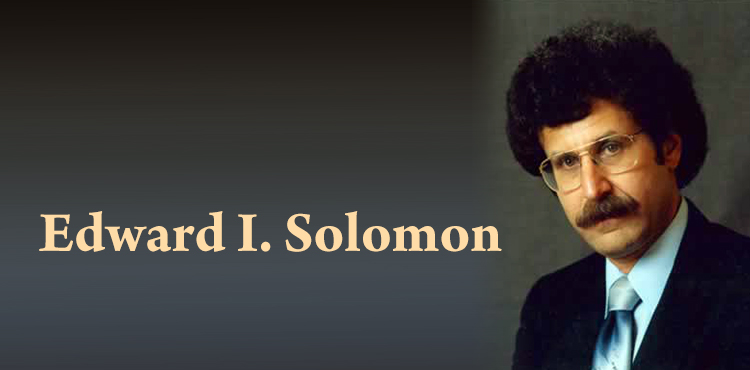
Edward I. Solomon
Monroe E. Spaght Professor in the School of Humanities and Sciences and Professor of Photon Science, Stanford University, USA
Reduction of O2 to Water by the Multicopper Oxidases
In nature the four electron reduction of O2 to H2O is carried out by Cytochrome c Oxidase (CcO) and the multicopper oxidases (MCOs). In the former, Cytochrome c provides electrons for pumping protons to produce a gradient for ATP synthesis, while in the MCOs the function is the oxidation of substrates, either organic or metal ions. In the MCOs the reduction of O2 is carried out at a trinuclear Cu cluster (TNC). Oxygen intermediates have been trapped which exhibit unique spectroscopic features that reflect novel geometric and electronic structures. These intermediates have both intact and cleaved O-O bonds, allowing the reductive cleavage of the O-O bond to be studied in detail both experimentally and computationally. These studies show that the topology of the TNC provides a unique geometric and electronic structure particularly suited to carry out this key reaction in nature.Ed Solomon obtained his Bachelor of Science at Rensselaer in 1968 and his M.A. and Ph.D. degrees from Princeton University in 1970 and 1972, respectively. He joined MIT as an Assistant Professor in 1975 and Stanford University as a Professor in 1982.
Professor Solomon’s research emphasizes the detailed application of a wide variety of spectroscopic methods combined with molecular-orbital calculations to probe the electronic structure of transition- metal complexes and their relation to physical properties and reactivity. His laboratory works in three general areas of physical-inorganic and bioinorganic chemistry.
The first is chemical and spectroscopic studies of metalloprotein active sites.? Studies in bioinorganic chemistry have focused on structure-function correlations in copper-cluster containing proteins, detailed spectral and theoretical studies of the unusual electronic structures of the blue copper, copper A and iron-sulfur active sites and their contribution to electron-transfer reactions, as well as the active sites in mononuclear and binuclear non-heme iron enzymes involved in O2 binding and activation.
The second research area is detailed spectroscopic and electronic structure studies of high symmetry transition-metal complexes. This research involves the application of polarized single-crystal electronic absorption, variable temperature-variable field magnetic circular dichroism, electron paramagnetic resonance, superconducting magnetic susceptibility, resonance Raman, photoelectron and x-ray absorption spectroscopies to important problems in transition-metal chemistry.
A third research emphasis is the development of synchrotron spectroscopy to solve important problems in inorganic chemistry. Projects include: 1) variable-energy photoelectron spectroscopy (PES) to probe small-molecule bonding interactions with metal-oxide surfaces related to heterogeneous, homogeneous and biological catalysis; 2) PES studies of electronic structure and electronic-relaxation contributions to electron-transfer processes in transition-metal complexes; 3) use of ligand K-edges in determining covalency of ligand-metal bonds; 4) development of metal L-edge X-ray absorption spectroscopy to probe metal sites in highly covalent ligand environments.
Remsen Award (1994);
Wheland Medal (2000);
ACS Award in Inorganic Chemistry (2001);
Frontiers in Biological Chemistry Award (MPI-2001);
Centenary Medal and Lectureship (Royal Society, UK 2003);
ACS Award for Distinguished Service in the Advancement of Inorganic Chemistry (2006);
Bailar Medal (2007);
Thomas Chemistry Scholar (2007);
Chakravorty Award & Lecturer (2008).
He is a Fellow of the American Chemical Society, American Association of the Advancement of Science, American Academy of Arts and Sciences, and a member of the National Academy of Sciences, USA.? He has served as an Associate Editor for Inorganic Chemistry for many years.

